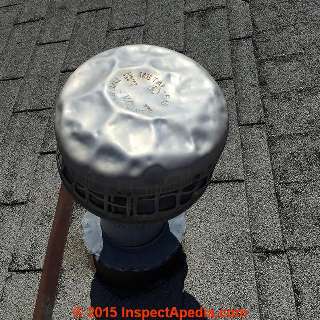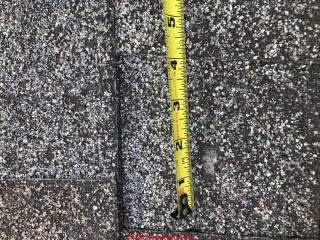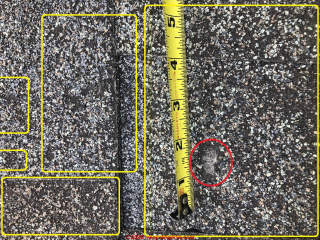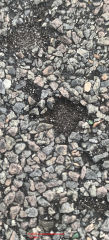 Asphalt Roof Shingle Hail Damage vs. Shingle Blister Damage
Asphalt Roof Shingle Hail Damage vs. Shingle Blister Damage
- POST a QUESTION or COMMENT about Roof Shingle Hail Damage & how Hail Damage is Distinguished from Blistering, Foot Traffic, or Other Roof Wear, & about Roof Inspection Procedures
Hail damage compared with blister rash damage on asphalt roofing shingles: how to tell the difference.
This article tells readers how to identify roof shingle hail damage and how to distinguish a hail damaged roof from blister rash damage, foot traffic damage, wind, and other conditions such as shingle rash blistering, cracking, and granule loss associated with normal shingle aging.
We include photographs and text that help identify different types of roof damage and wear, and we discuss up-close examination of wear areas to improve the accuracy of roof damage or wear diagnosis.
InspectAPedia tolerates no conflicts of interest. We have no relationship with advertisers, products, or services discussed at this website.
Hail Damage Compared to Asphalt Shingle Blister Damage
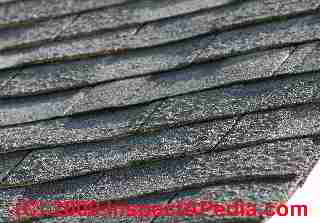
Asphalt shingle blistering or rash blisters or other visual anomalies on a roof surface versus visual evidence of asphalt shingle hail damage can be tricky to distinguish.
Some owners and some roof inspectors who have not seen various types of roof damage may have difficulty distinguishing between blistering, thermal splitting, age cracking, general product wear and granule loss, and other markings on asphalt roof shingles due to specifically hail, ice, or other storm damage.
Shingle rash blisters [BLISTERS on ASPHALT SHINGLES] on asphalt shingles result from the manufacturing process, (and may be cosmetic or possibly a more serious defect) which are sometimes mistaken for hail damage. - [Photo above /left courtesy of reader Jim Todd.]
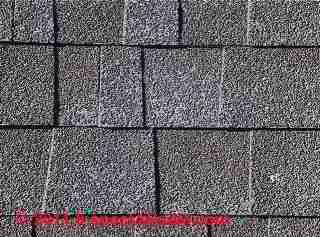
Hailstones can be quite large, even golf-ball sized or baseball-sized in some cases. Hail might produce a "dent" or a damage point in an asphalt shingle roof surface, resulting in granule loss and reduced remaining roof life. But I'm highly doubtful that hail ever produces raised "blisters" on the shingles such as shown in our description
Hail damage can dislodge the protective mineral granules of an asphalt shingle, producing areas of exposed asphalt shingle substrate. If inspecting an asphalt shingle (or mineral-granule-covered roof roofing) roof shortly after a hailstorm the exposed shingle substrate should be expected to show freshly-exposed asphalt coated or asphalt impregnated shingle base material.
If the same area is examined much later the exposed shingle areas of granule loss may have weathered or even cracked and this distinction (hail versus wear or other sources of granule loss) will be more difficult to distinguish.
Hail damage to metal components on or at buildings: Justin Reichl, a roofing sales representative trainer who has written about hail damage, points out that unlike shingle blister rash or other causes of granule loss on asphalt shingle or roll roofing surfaces, hail damage might also cause damage or visible markings on metal components on or around buildings.
The photo above of a smashed aluminum B-vent cap or chimney cap is believed to have been caused by hailstones; you'll notice that the asphalt roof shingles on what looks like a rather low-slope roof look as if they've lost mineral granules. Photo provided courtesy of Justin Reichl cited at REFERENCES.
For larger hailstones Reichl points out that you might find downward-impact dents on gutters, flashings, metal roof vent covers, and even on the finned surfaces of condensing coils on the compressor/condenser unit of air conditioners or heat pumps.
Damage to the compressor/condenser condensing coil fins is more likely if the hail is blowing at an angle with respect to horizontal surfaces. See Reichl atReferences or Citations
Asphalt shingle blisters, are raised bumps or protrusions in shingle surface, either closed blisters or open ones showing
a small black pit or crater when the protective mineral granules have been lost from the peak of the blister.
Photos of Asphalt Shingle Blisters Converting to Pitting

Asphalt roof shingle manufacturers emphasize that blisters on shingles are simply a cosmetic matter and that they do not impact the wear life of the roof nor do they impact the roof shingle warranty.
See BLISTERS on ASPHALT SHINGLES and our shingle blister photo at left for examples of shingle blistering.
See SHINGLE HAIL DAMAGE EXAMPLES for some examples of hail damage where shingle blistering may have been a factor in granule loss.
We are not sure that everyone would agrees about the impact of blistering on shingle life nor the view that blistering cannot ever affect the roof life.
While on some roofs blistered shingles may last at least as long as the shingle warranty period., in other cases, especially if the blistered roof is exposed to mechanical damage (being walked-on, for example) or other challenging exposure conditions, the blisters may play a role in roof wear and roof life, as we elaborate below.
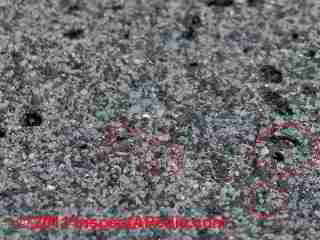
In at least some cases, blistered asphalt shingles are more easily converted to pitted shingles by foot traffic, hail, and in some cases during the course of aging but before the end of the shingle warranty period.
Our photo (left) shows blisters on an Atlas brand asphalt shingle roof in Georgia. Some, circled in red [click to enlarge] show remaining blisters that are either not opened to its or are just beginning to open.
The blister-damaged Atlas brand roof shingle shown at left is not the hail-damaged Owens Corning brand asphalt shingle roof described by reader B.L. in this article.
In those cases, in our OPINION and also our EXPERIENCE, because mineral granules have been lost from the shingle surface sufficient to expose the shingle asphalt-impregnated substrate to the sun and weather, the shingle wear rate may accelerate and the shingle life may be reduced.
CONTACT us to suggest technical corrections, additions, or references on hail damage and blister damage to roofing.
Question: How Can You Distinguish Between Blister Damage and Hail Damage on an Asphalt Shingle Roof?
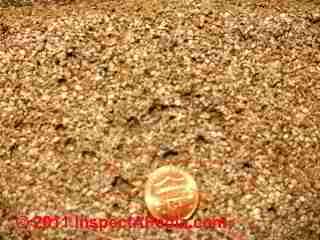
I notice your website attributes blistering most frequently to organic (rag based) asphalt shingles. So, I have a question for you:
My roof [on a Pennsylvania home] has 13 year old Owens Corning three tab 25 year warranty Supreme fiberglass shingles. After a severe hail storm on 29 March 2009, with wind gusts of 60+mph and .88" diameter hail, my roof sustained severe damage to the southern roof slopes.
The southern slopes were perpendicular to the incoming hail. After the storm, I had over 1/2" of granules in a brand new gutter and the southern slopes were strewn with thousands of 1/8" to 3/16" pits. The underside of the shingles did not show any cracking or indentations (as would be expected from .88" diameter hail).
I was on my roof 5 months prior to the storm and replaced 3 pipe boots on the southern roof slopes. The shingles NEVER exhibited any raised bubbles; they were always smooth and flat. My weight did not disturb anything more than a few stones from the roof surface.
Prior to the storm, there was nothing on my roof that looked like the attached photo. (Please see the photo [above left, sharpened by InspectAPedia.com] - sorry it is a little blurry).
An inspector from the insurance company is saying my 13 year old roof is blistered. He showed me a photo of burst blisters, which I have to admit, looked like my damage. All the research I can find (by the way your web-site is awesome!), indicates that 13 year old fiberglass shingles don't suddenly develop a manufacturing or installation issue known as blistering. I say this is hail damage!
My question is this: have you ever seen this scenario before and can you draw any conclusions from my information? - B.L., Pennsylvania
Reply: Blisters on Asphalt Shingles,Should Be Visible In and Out of the Hail Damage Area & on All Slopes Regardless of Roof Orientation & Direction of Hailstones if They Are or Were Present Before the Storm
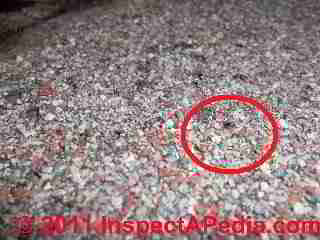 A competent onsite inspection by an expert usually finds additional clues that help accurately diagnose a problem. That said, here are some things to consider:
A competent onsite inspection by an expert usually finds additional clues that help accurately diagnose a problem. That said, here are some things to consider:
Here is my reasoning on the question of distinguishing among simple hail damage, hail damage to a blistered roof, and shingle blister wear on a roof:
- Shingle pitting: Your photo of roof damage [at the start of this Q&A] after the hail storm is blurry but it clearly shows pitting on the shingles on this home in Pennsylvania.
Your second photo (shown at left, click to enlarge) shows what may be a pre-existing blister - circled - whose top has been opened.
You will want to survey the roof surface carefully, perhaps in early morning or late afternoon angled sunlight or even at dusk with a flashlight shone along the surface, in order to see what other roof blisters may be present in various areas of the roof and thus to decide what role pre-existing blisters, even if they were not previously open or "burst" may have played in the hail damage. - Hail dents or cracks in shingles? We are not sure that hail will necessarily produce cracks or dents shown on the underside of asphalt roof shingles. That material, if the roof shingles are not old, dried and brittle, is resilient to impact.
Cracks in my experience come with age, loss of volatiles, and shingles becoming dried and brittle. Or in some cases cracks occur from defective product. - The presence of mineral granules in the gutters or on the ground in quantity appearing after a hailstorm and in the previously new clean gutters is a strong indication that the roof suffered granule loss during the storm.
A question is where there previous blisters on the shingles and did that play a role in the granule loss and does that affect the shingle warranty or an insurance claim for hail damage following a hail storm.

- A common form of hail damage to asphalt roofing is a shingle scouring effect shown in our photo (left). But if a roof were blistered before the storm those raised areas might play a role in granule loss from hail impact.
- Shingle blisters deteriorate: We agree with the insurance company investigator that shingle blisters (see BLISTERS on ASPHALT SHINGLES) can deteriorate to shingle pitting, and often will ultimately do so from foot traffic or just shingle aging depending on how long the shingles remain on the roof.
- Blisters on asphalt shingles can also convert to pitting due to hail damage, and in that case one might argue that the roof age or wear was accelerated by the hail storm that burst the blisters leaving the pits.
- Find un-burst shingle blisters: But if blisters were the source of pitting on your roof, one would expect to find some remaining, un-burst blisters, perhaps lower in profile.
It seems to me less likely that even on a blistered roof we would get 100% blister bursting in a hailstorm. So a careful inspection should find some remaining blisters, or at a minimum, raised edges (previously blister edges) around the pits on the shingles now, after the storm. - If there are NO blisters on the roof shingles now, and considering that you report not having seen blisters before the storm, and since post hail we see just pits (no unopened blisters), and particularly if the pitting occurs on the slopes most impacted by the hail, hail damage sounds like a likely explanation.
DIY Shingle Test Attempts to Replicate Shingle Damage from Hail
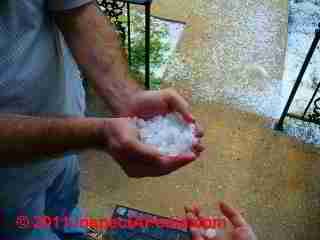
B.L. continued our hail damage and roof blister discussion with a do-it-yourself home test of roof shingles and more photographs of shingle granule loss.
This discussion has moved to a separate article found at
SHINGLE HAIL DAMAGE REPLICATION
Watch out: readers should keep in mind that cooking potentially combustible materials in a home oven is a potential fire hazard.
Question: Is this hail damage or something else?
2020/04/23 Scott said:
Is this hail damage or something else?
Moderator reply:
Scott
I would be reluctant to judge a roof hail damage (vs other wear and granule loss causes) from just a single photo of a few square inches and with not any information about the roof.
There is certainly pitting and granule loss, but to decide between hail damage and more-isolated damage from walking on a fragile or blistered surface you'll want to inspect further and to get more data:
- location and age of the roof,
- recent hail or weather damage data,
- record of when the damage was first observed.
- results of inspecting the entire roof, comparing the condition of various slopes, locating the areas of damage vs the entire roof area
I'm including an annotation of your photo marking all of the wear and granule loss I see on the roof - this *could* be from hail.
There is a lot more granule loss (outlined in yellow) than that single pitted spot where the fiberglass substrate shows through (circled in red).
Usually hail damage is characterized by granule loss in cratered wear spots - see the article above on this page and also see
HAIL DAMAGED SHINGLES & OTHER ROOF COVERINGS
Roof blister damage versus hail damage Summary
- Regardless of whether or not there are blisters or blister rash on your roof shingles, if there were pre-existing blisters that were not opened, if there were no visible pits or craters or areas of exposed shingle substrate prior to the hail storm and no significant volume of mineral granules appearing in your roof gutters or on the ground at the ends of downspout leaders before the storm,
and if those conditions were in fact observed after the storm, that is a compelling argument for asserting that the damage was caused by the hailstorm. - A rebutting argument that is plausible is that sometimes people do not notice a pre-existing condition until events make them take a closer look, thus confusing old with new conditions.
The assessment of this argument turns on the timing and confidence in earlier observations made of or on a roof. - You should inspect the roof for the extent of blistering in order to determine if that condition may have been a factor in the extent of damage caused by subsequent hail damage.
Using an oblique light when the roof is not in direct bright sunlight should be helpful, as you can see in some of our other photos of roof shingle blister rash. - Watch out: Indeed foot traffic on roofs, especially in hot weather or on old brittle roof shingles can cause extensive damage.
Often we can see on an older roof just where the "inspector" walked by the foot traffic damage, and often we see foot traffic damage concentrated in areas where someone was standing to do work such as around a chimney.
Reader Comments, Questions & Answers About The Article Above
Below you will find questions and answers previously posted on this page at its page bottom reader comment box.
Reader Q&A - also see RECOMMENDED ARTICLES & FAQs
Question: Shingle blistering or just hail damage?
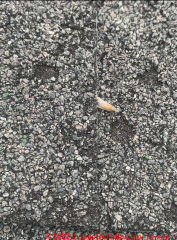 ...
...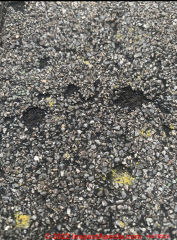
I’ve been researching shingle blistering on the web and found a lot of good info on your website. State Farm says the following is blistering, which is a new term to me. Any idea where I can verify this is actually true? My roofer says hail damage, state farm says otherwise.
Thanks sir - Anonymous by private email 2022/07/13
Moderator reply:
Shingle blistering and hail damage are closely related.
Once there are shingle blisters on an asphalt shingle it's vulnerable to hail damage in that during a hailstorm the hailstones will often scour off the raised blisters.
You can offten map hail damage against blistering by noticing differences in the condition of different slopes or sections of the roof on your home.
Hail is often directional, so there may be one slope that's more damaged than another.
So you might find blisters on both slopes but blisters broken open on the more hail-exposed slope.
Insurance Companies would like to cite blistering as a cosmetic defect but it's more than that over the life of the roof.
Trying to thread the needle of this argument fairly we often find ourselves saying that blister's are a cosmetic defect, as the shingle manufacturer says, and as an insurance company would like to say, until there's a hail storm that opens the blister tops.
We also see blister tops lost by foot traffic where people have walked on an older blistered shingle roof.
Bottom line, if the hail storm caused damage whrre roof shingles were blistered, then you will find other blistered shingle areas on the roof which blister tops remain in place.
If you look carefully across the whole roof surface and there are no blisters, only pits where hailstones struck, then the problem may only be related to a hall storm event.
Reader follow-up:
Good info! Where would you turn if you were in my shoes? I only have this type of damage on the South side of the roof. I’ll have to check the north side for any “raised blisters.”
Moderator reply:
So let's start by inspecting that other slope.
Where is the building located, and when was the building constructed, and when were the current roof shingles installed ?
Do you have any details such as the brand and model of the shingle?
Reader follow-up:
It’s a residence in Lake Ozark, MO 65409 is the zip code. The house was built in 1976 but this roof was put on as a replacement in about 2005. We have no records from the previous owner as to shingle manufacturer.
Moderator reply:
Seeing the photos that you sent, I can't make out shingle blisters, but the very round shape of some of the areas where granules have been lost are consistent with a blister top being scoured off.
I look forward to seeing some equally sharp photos of other shingle surfaces where perhaps you may find some raised shingle blisters.
On a roof the age of yours this is about when you would begin to see some of those blisters open up, but of course the hail would have definitely exposed that condition.
Reader follow-up:
Thanks for your help! I’ll be at the house in question tomorrow. I hope to get a picture of the roof when the sun is first coming up so as to either show or not show a plateau of the blister.
Moderator reply:
Thanks for your help! I’ll be at the house in question tomorrow. I hope to get a picture of the roof when the sun is first coming up so as to either show or not show a plateau of the blister.
...
Continue reading at SHINGLE HAIL DAMAGE REPLICATION or select a topic from the closely-related articles below, or see the complete ARTICLE INDEX.
Or see these
Recommended Articles
- HAIL DAMAGED SHINGLES & OTHER ROOF COVERINGS - home
- SHINGLE HAIL DAMAGE vs SHINGLE BLISTER RASH
- SHINGLE HAIL DAMAGE REPLICATION
- SHINGLE HAIL DAMAGE CHALK MARKING CODES
- SHINGLE HAIL DAMAGE RESISTANT PRODUCTS
- WARRANTIES for ROOF SHINGLES
Suggested citation for this web page
SHINGLE HAIL DAMAGE vs SHINGLE BLISTER RASH at InspectApedia.com - online encyclopedia of building & environmental inspection, testing, diagnosis, repair, & problem prevention advice.
Or see this
INDEX to RELATED ARTICLES: ARTICLE INDEX to BUILDING ROOFING
Or use the SEARCH BOX found below to Ask a Question or Search InspectApedia
Ask a Question or Search InspectApedia
Try the search box just below, or if you prefer, post a question or comment in the Comments box below and we will respond promptly.
Search the InspectApedia website
Note: appearance of your Comment below may be delayed: if your comment contains an image, photograph, web link, or text that looks to the software as if it might be a web link, your posting will appear after it has been approved by a moderator. Apologies for the delay.
Only one image can be added per comment but you can post as many comments, and therefore images, as you like.
You will not receive a notification when a response to your question has been posted.
Please bookmark this page to make it easy for you to check back for our response.
Our Comment Box is provided by Countable Web Productions countable.ca
Citations & References
In addition to any citations in the article above, a full list is available on request.
- Reichl, Justin, "How to Spot Hail Damage (with pictures)", [web page], Justin Reichl, Roofing Life, Tulsa, Oklahoma, USA, Tel: 918-978-6544, Email: info@roofing.life Website: www.roofing.life, retrieved 2015/12/28, original source: https://www.roofing.life/hail-damage-roof/
- Our recommended books about building & mechanical systems design, inspection, problem diagnosis, and repair, and about indoor environment and IAQ testing, diagnosis, and cleanup are at the InspectAPedia Bookstore. Also see our Book Reviews - InspectAPedia.
- In addition to citations & references found in this article, see the research citations given at the end of the related articles found at our suggested
CONTINUE READING or RECOMMENDED ARTICLES.
- Carson, Dunlop & Associates Ltd., 120 Carlton Street Suite 407, Toronto ON M5A 4K2. Tel: (416) 964-9415 1-800-268-7070 Email: info@carsondunlop.com. Alan Carson is a past president of ASHI, the American Society of Home Inspectors.
Thanks to Alan Carson and Bob Dunlop, for permission for InspectAPedia to use text excerpts from The HOME REFERENCE BOOK - the Encyclopedia of Homes and to use illustrations from The ILLUSTRATED HOME .
Carson Dunlop Associates provides extensive home inspection education and report writing material. In gratitude we provide links to tsome Carson Dunlop Associates products and services.


